Independent evaluation of each ear leads to best results

By Sarah A. Sydlowski, AuD, PhD; Rachel Vovos, AuD; and Erika Woodson, MD
Cleveland Clinic is a non-profit academic medical center. Advertising on our site helps support our mission. We do not endorse non-Cleveland Clinic products or services. Policy
Current FDA indications for cochlear implantation in adults include moderate to profound bilateral sensorineural hearing loss with poor speech recognition in the best-aided condition. However, patients with asymmetric hearing loss (AHL) often present with a very poor hearing ear (one that meets FDA criteria when assessed individually) and a better hearing ear (one that falls outside these criteria). These patients report significant hearing challenges and a lack of benefit from hearing aids alone.
The staff of Cleveland Clinic’s Hearing Implant Program recognize that AHL poses significant difficulties, and we are actively developing ways to accurately assess communication challenges and identify management options that will help these patients achieve the best hearing possible.
Patients with significant AHL have difficulty understanding speech, particularly speech in noise, even if their better hearing ear exhibits normal hearing thresholds. Furthermore, speech perception scores in the best-aided condition often reflect the abilities of the better hearing ear. As a result, a traditional bilaterally aided assessment is not generally representative of a patient’s real-world hearing abilities.
In many cases of AHL, the poorer ear cannot benefit from amplification because its speech recognition ability is reduced. Therefore, patients cannot take advantage of the binaural benefits that are critical for speech understanding, even if they pursue amplification of the poorer ear or use a BiCROS system.
The only option for true binaural hearing for patients with AHL may be cochlear implantation in the poorer hearing ear and a hearing aid in the contralateral ear (bimodal hearing).
Members of our Hearing Implant Program team recently conducted a retrospective analysis of the pre- and postoperative speech perception abilities in six bimodal recipients with AHL. All six patients had received their cochlear implant in our program under off-label indications. A chart review was conducted to determine if bimodal stimulation would benefit patients who have only one ear that meets cochlear implant candidacy criteria. We hypothesized that the use of both a cochlear implant and a hearing aid (which together provide adequate binaural stimulation) would result in better understanding of speech in both quiet and noise than the use of bilateral hearing aids.
The hearing aids were programmed on the basis of each patient’s most recent audiogram (Figure 1). The settings were verified with an Audioscan Verifit® system using simulated real-ear measures and NAL-NL1 targets prior to testing in the right-aided, left-aided and bilaterally aided conditions. Speech materials were presented at 60 dB(A) in the soundfield at 0 degrees azimuth.
We then compared individual preoperative aided scores with postoperative scores in the cochlear implant-only and bimodal conditions, referencing published confidence intervals to determine clinically significant differences. Paired t tests were used to compare the group’s mean scores for each speech parameter measured (Figure 2):
Compared with baseline, we found that all six patients performed significantly better in quiet and in noise when listening with their poorer hearing ear alone. Most of these improvements were observed within one month of activation. Notably, three patients performed significantly better on at least one measure with their cochlear implant alone than they had preoperatively with two hearing aids. Moreover, all but one patient (P4) performed significantly better in the bimodal condition than with the bilateral hearing aids preoperatively (the one outlier was an inconsistent cochlear implant user whose intermittent use likely affected her outcomes).
The advantages of bimodal hearing for traditional cochlear implantation candidates are well documented. Postimplant hearing in patients who had substantial preoperative hearing in the contralateral ear has been shown to surpass preoperative levels. Associated binaural benefits ultimately lead to better speech understanding in the bimodal condition than with either a cochlear implant or a monaural hearing aid alone. Patients with AHL also demonstrate improvement in sound detection, word and sentence recognition, and localization with use of a cochlear implant in the poorer hearing ear.
We conclude that patients with AHL receive significant benefit from bimodal stimulation, even when the hearing in the better ear does not meet FDA implantation criteria. Intervention through cochlear implantation may provide important binaural stimulation that cannot be adequately achieved with either bilateral hearing aids or the use of a BiCROS system. Moreover, treatment of individual ears is important to avoid the negative effects of auditory deprivation in an ear that cannot be adequately aided. To adequately assess and identify these potential cochlear implant recipients, we must evaluate each ear independently. Our current assessment protocol has been updated accordingly, and we are diligent in considering the abilities of each individual ear when evaluating a patient for cochlear implant candidacy, particularly in challenging situations such as background noise.
Dr. Sydlowski (sydlows@ccf.org) is Audiology Director of the Head & Neck Institute’s Hearing Implant Program
Dr. Vovos (biblerr@ccf.org) is a clinical audiologist in the Head & Neck Institute’s Section of Audiology
Dr. Woodson (woodsoe@ccf.org) is Medical Director of the Hearing Implant Program
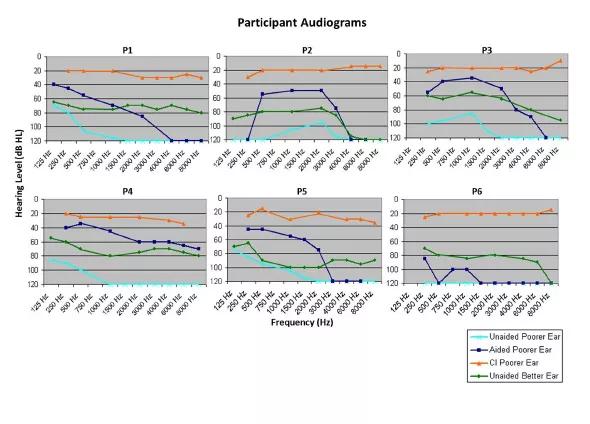
Figure 1. Graphs show hearing thresholds in each patient as a function of frequency. Preoperative unaided thresholds are represented by the green lines (better ear) and turquoise lines (poorer ear). Blue lines represent preoperative thresholds obtained for the poorer hearing ear with use of a hearing aid. Orange lines represent the postoperative cochlear implant-assisted thresholds in the same ear. Aided and implantassisted thresholds were obtained in the soundfield using FM-warbled tones. Note that the responses marked at 120 dBHL represent no response at equipment limits.
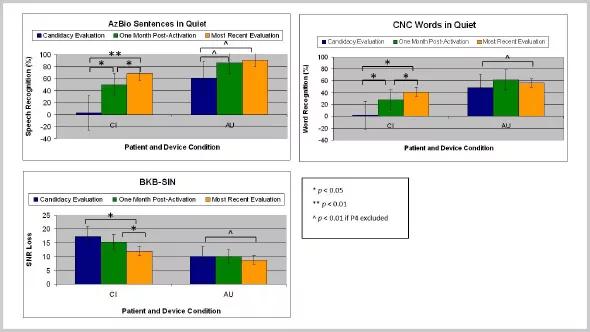
Figure 2. Bar graphs show the entire group’s mean scores in the implanted ear and the bilaterally aided (candidacy evaluation) or bimodal (one month and most recent) conditions pre- and postoperatively for each test. CI = implanted ear only; AU = bilaterally aided/bimodal.

Research on children with UHL explores the quality-of-life benefits and outcomes of cochlear implants
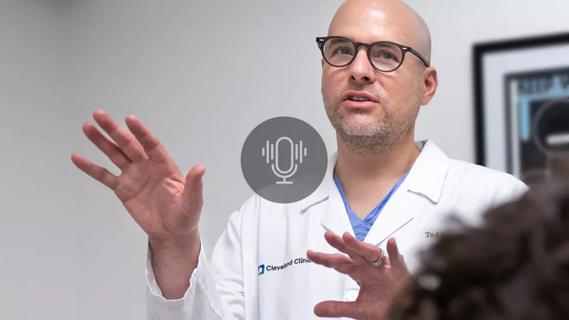
A look at how custom-fitted oral appliances work and when they’re a good fit for patients
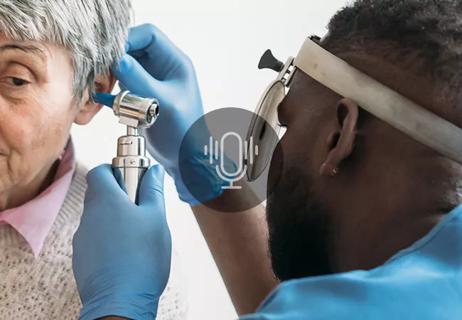
Hearing loss and its treatments are often misunderstood by both the public and healthcare professionals
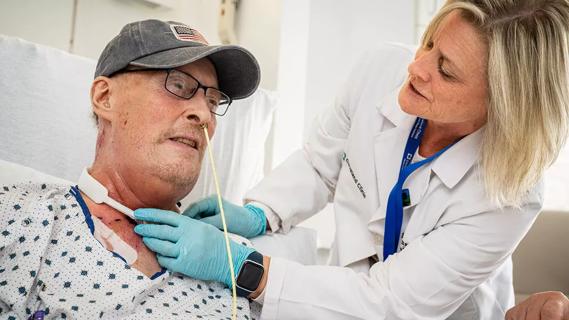
Modified Barium Swallow Study and Flexible Endoscopic Evaluation of Swallowing can both be used to diagnose dysphagia, but it’s important to understand their advantages and disadvantages
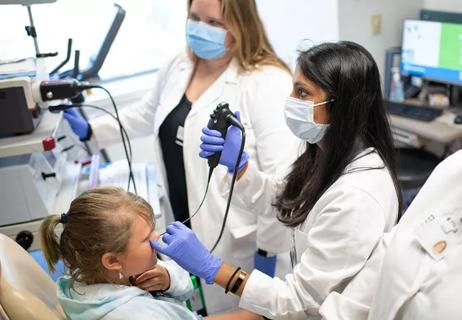
By working in tandem, a pediatric otolaryngologist and speech-language pathologist can diagnose conditions and develop treatment plans in the same visit

Because EILO is a relatively new condition, educating care providers to help diagnose and treat earlier is critical

A Cleveland Clinic speech-language pathologist describes the techniques she uses with her patients and how new research reinforces that patients should be driving care decisions

The treatment is simple and effective for many patients, but more research is needed to determine the exit-strategy from repetitive injections